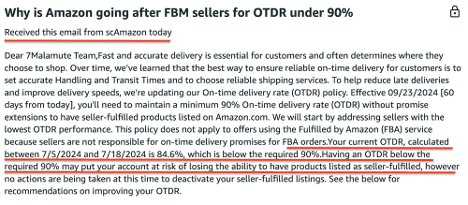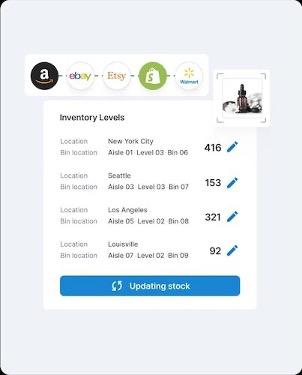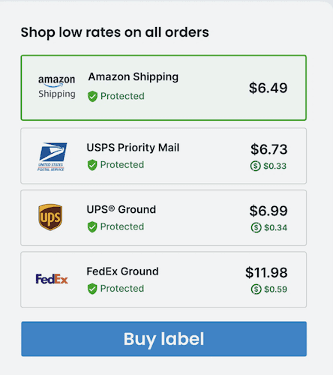Amazon
How to Stay Compliant With Changing Rules for Selling On Amazon
- Written by Kaleigh Moore

How to stay compliant with changing rules for selling on Amazon
With new compliance policies, what worked for your Amazon seller account yesterday might not work today. Amazon is constantly raising the bar for transparency, customer support, and seller accountability—and it’s apparent in their constant updates related to stricter shipping requirements, tighter review policies, and particular listing standards.
In this guide, we’ll break down the latest Amazon policy changes impacting sellers in 2025 (including critical updates from late 2024), explain the performance metrics that could trigger account warnings, and offer practical, automation-friendly strategies to help your business stay compliant.
What you need to know about Amazon's key policy changes in 2025
While Amazon hasn’t announced any new seller policies in 2025 so far, changes from September 2024 continue to impact Amazon Sellers. Here are some key policy changes to look out for in 2025 and beyond:
1. On-time delivery rate (OTDR) Policy
Effective date: September 25, 2024
Sellers must maintain a minimum 90% On-Time Delivery Rate (OTDR) for seller-fulfilled orders. This means the percentage of orders delivered on or before the promised date, without any extensions.
If you fall below this threshold, Amazon might remove your seller-fulfilled listing from its site, but it will likely notify you of the violation beforehand.
For instance, a seller with an OTDR of 84.6% between July 5 and July 18, 2024, received warnings about potential listing restrictions.

2. Product compliance documentation requirement
Effective Date: September 30, 2024
Effective September 30, 2024, Amazon mandates that sellers submit and obtain approval for necessary compliance documents before listing new products on its marketplace. The aim is to enhance customer safety and ensure all products meet safety regulations and industry standards.
While the exact documents will depend on the product category, sellers might need to submit documents like:
Children’s Product Certificate (CPC)
General Certificate of Conformity (GCC)
Test reports from ISO 17025 accredited laboratories
Nationally Recognized Testing Laboratory (NRTL) compliance documentation for electrical products
3. Updated shipping settings
Effective Dates:
New transit time limits: August 25, 2024
Automated handling time enforcement: September 25, 2024
Amazon rolled out stricter shipping expectations in late 2024. If you’re a seller who fulfills orders yourself (FBM), this change can directly affect your ability to keep listings live and avoid account health issues.
Here’s what changed:
Transit time caps: Amazon now limits standard shipping to at most five business days and free economy shipping to eight days within the U.S.
Automated handling time: If your manually set handling time is way slower than your actual fulfillment history, Amazon will override it. They’ll automatically shorten it to match your real performance data.
For instance, if you always ship orders in a day, but your settings say 3 days, Amazon will reduce your handling time to 1 day. This means buyers will expect faster delivery, and you’ll be expected to meet that timeline.
Strategies to meet Amazon’s compliance (a quick checklist)
Failing to meet Amazon’s benchmarks can result in listing suspensions, losing your perks, and even account deactivation. No matter the repercussions, it can undo all the efforts you put into building your seller account.
Here’s a quick checklist (along with strategies) to help you stay compliant, keep your customers happy, and keep Amazon’s ire at bay.
Strategies for on-time shipping
As you’ve seen, Amazon has high expectations when it comes to on-time shipping. Here are some ways to not only meet but exceed those expectations:
Sync inventory in real-time to avoid last-minute scrambling:
A missing item can be a culprit behind a late order. When your inventory count isn’t correct, you risk confirming orders you can’t fulfill, resulting in delays and pre-fulfilment cancellations.
That’s where tools like Veeqo can help. As an Amazon company, Veeqo is naturally built to align with Amazon’s systems and standards. The fulfillment and inventory tracking platform syncs your stock levels in real time across Amazon, your warehouse, and other sales channels, helping you prevent overselling before it becomes a problem.
For example, eChapps, a toy retailer with $8.5 million in annual sales, switched to Veeqo and consolidated all its multichannel orders into a single dashboard.

The result? A noticeable reduction in fulfillment errors and $15,000 in annual savings, while eliminating the kind of inventory chaos that typically causes last-minute shipping delays.
And since Veeqo is part of Amazon, it evolves with Amazon’s policies, so sellers can stay compliant no matter how the rules change.
Set clear pick/pack deadlines for your team:
Another cause of fulfillment delay could be the staff not working against a clear daily schedule. Without structure, you risk missing priorities, tasks piling up, and late shipments.
Even in large-scale operations, like at Mead Johnson Nutrition, research showed that inconsistent delivery schedules led to factory downtime, while structured timeslots created a steadier time flow in the deliveries.
For your warehouse, that could be as simple as setting a daily 2 PM cutoff for Prime orders and holding a 5-minute morning stand-up to review high-priority shipments. It’s a low-lift change that can bring serious consistency to your fulfillment cycle.
Partner with reliable carriers:
Even after you’ve done everything you can to ensure the package reaches the customer on time, your carrier can still cause a delay. From lost tracking to inconsistent service from shipping partners, anything could tank your on-time delivery rate.
The only way to avoid this is by partnering with nationally recognized carriers like USPS, UPS, FedEx, or DHL—ones Amazon trusts and that consistently provide valid tracking updates.
Better yet, Veeqo offers access to a network of over 50 pre-integrated shipping carriers. The platform automatically compares rates and delivery times side by side, so you can select the most reliable or cost-effective option based on the customer’s location and shipping expectations, without the need to toggle between multiple carrier sites.

Strategies to meet Amazon’s customer service expectations
Amazon places a premium on customer service, and failing to meet their expectations can have dire repercussions, including loss of reputation and account suspension.
Here’s how to meet Amazon’s customer service expectations:
Automate customer support to handle high volumes:
With access to automated customer support, you don’t have to rely solely on manual responses. While AI-powered bots aren’t meant to supplant human agents, they can work alongside them to address routine inquiries like order status and return policies.
It helps you respond faster and reduce backlog, keeping customers satisfied and your seller metrics intact.
Take Topicals, for example—a fast-growing personal care brand. By automating common customer questions, they saw a 78% increase in sales from customer support interactions and raised their customer satisfaction score to 4.8 out of 5.
Pro tip: Create a library of pre-defined response templates for common questions to keep communication consistent and quick.
Understand and avoid common customer service violations:
Amazon expects its sellers to provide customer service that’s just as exceptional as their shipping.
Here’s everything you need to consider to deliver a customer experience that Amazon will recognize and reward:
Don’t address buyer responses late: Amazon requires sellers to respond to customer queries within 24 hours, whether on holidays or weekends. AI-powered bots will come in handy here to respond to repetitive queries around the clock.
Improper handling of returns or refunds: Follow Amazon’s return policy to the T and process refunds within 48 hours of receiving the item. Failing to approve valid return requests, delaying refunds, or rejecting returns without valid cause may lead to A-to-Z Guarantee claims.
Arguing with customers or using unprofessional language: Amazon will flag any rude, argumentative, or dismissive language, even if you’re right. So, regardless of the nature of the customer query, keep emotion out and address the customers with a calm, composed demeanor.
Too many order cancellations due to stockouts: Use a real-time inventory sync tool like Veeqo to keep track of your inventory and avoid overselling and confirming an out-of-stock order. You can also set inventory buffer levels for fast-moving items.
Strategies to meet Amazon’s product listing compliance
Amazon doesn’t cut corners when it comes to product listings either. To maintain consistency and trust, it has clear rules that every seller must follow to keep their account active and in good standing.
Crafting compliant product titles:
As of January 21, 2025, Amazon has updated its product title requirements to help sellers craft clear and consistent product titles.
Key guidelines include:
Character limit: Titles must not exceed 200 characters, including spaces.
Prohibited characters: Avoid using special characters such as !, $, ?, _, {, }, ^, ¬, and ¦ unless they are part of the brand name.
Repetition: Do not repeat the same word more than twice in a title (basically, no keyword stuffing!), except for articles, conjunctions, and prepositions.
Rules for product titles, descriptions, and images.
Avoiding prohibited claims and misleading information.
Recent crackdown on fake reviews and brand policy violations (with examples)
Writing accurate descriptions and using bullet points:
Like the titles, Amazon expects your product descriptions and bullet points to provide clear, truthful information about the product.
Here’s everything you must avoid:
Misleading claims: Don’t make unverified claims about the product's capabilities.
Subjective and promotional language: Avoid using unverifiable and promotional terms like "best," “affordable,” or "top-rated" without substantiation.
Bullet points: Include at least 3 bullet points to increase your description’s readability.
Time-sensitive information: Avoid phrases like "new release" or "limited time offer" unless accurate.
Pro tip: Keep it factual, with information about materials used, dimensions, and compatibility.
Using appropriate images:
Images are one of the biggest draws of Amazon listings. Your images and videos should clearly reflect your product's essence.
Here’s everything your images must have:
Main image: Features the product against a pure white background (RGB 255, 255, 255)
Quality: To enable zoom functionality, your image should be high-resolution, 500 to 1000 pixels on the longest side.
Format: Provide your images in JPEG (.jpg or .jpeg), TIFF (.tif), PNG (.png), or non-animated GIF (.gif) file formats
Content: Do not include additional text, logos, or watermarks on images.
Don’t make prohibited and misleading claims:
Amazon prohibits specific claims, especially those related to health and safety.
Don’t make the following claims without proper documentation:
Health claims: Don’t claim that your product can diagnose, cure, treat, or prevent diseases without FDA approval.
Certifications: Don’t suggest that your product is "FDA approved" or "EPA registered" without proper documentation.
You're not entirely prohibited from making claims about what your product can do—you just need to ensure those claims are backed by credible evidence.
Don’t solicit fake reviews:
In 2024, Amazon filed a lawsuit against Bigboostup.com for selling fake reviews—one of many legal actions the company has taken to protect the integrity of its marketplace.
Amazon’s message is clear: fake reviews aren’t tolerated.
Here’s how to stay on the right side of the policy:
Don’t offer free products, discounts, or rewards in exchange for reviews. Amazon sees this as manipulation, even if the review is honest.
Don’t use third-party services to boost your star ratings or “manage” reviews. These are often flagged as black-hat operations.
Don’t ask friends, family, or employees to leave reviews. Amazon’s detection system is smart enough to detect biased reviews.
Further reading: 7 Ways to Avoid Selling Privilege Suspension by Amazon
Additional performance metrics that may trigger account warnings
Amazon doesn’t randomly hand out suspensions—it relies on a strict set of performance metrics every seller should know.
Here are some performance metrics that may trigger account warnings:
1. Order Defect Rate (ODR)
Threshold: Less than 1%
As the name suggests, ODR measures the percentage of orders with defects, including negative feedback, A-to-z Guarantee claims, or credit card chargebacks.
Brands with vague listings or poor-quality images often see higher ODRs because the product delivered doesn’t match customer expectations. If you cross the threshold, Amazon might remove your “Buy Box” eligibility and even terminate the account altogether.
It might even lead to a drop in sales. For instance, one seller noted significant drops in sales when their ODR rose to 1.7%, citing a decrease from 40–60 units per day to just 8–11 units.

How do you keep your ODR below 1%? Here are some quick tips:
Double-check to ensure your listings match the actual product, especially size charts and compatibility details.
Proactively and promptly respond to customer queries before they turn into negative reviews.
Use Amazon’s own fulfillment tool, like Veeqo, to ensure inventory, order details, and shipping labels are synced across platforms so customers see exactly what they get.
2. Late Shipment Rate (LSR)
Threshold: Less than 4%
Amazon and your customers don’t care whether your warehouse is understaffed or why the courier was late—they expect your ship confirmations to be on time. LSR refers to the percentage of orders confirmed shipped after the scheduled ship date, and a high LSR can trigger warnings and even account suspension.
In fact, a seller shared how their account was suspended upon exceeding the 4% limit for LSR despite submitting multiple action plans. Clearly, Amazon doesn’t take this metric lightly.
How do you avoid exceeding the 4% LSR mark? Here are some actionable tips:
Audit your actual vs. promised ship times every week. If you’re consistently shipping early or late, update your handling time.
Use Veeqo to batch-print and bulk-process labels. It also connects to major carriers and automatically marks orders as dispatched, eliminating the risk of “forgotten” confirmations.
3. Pre-Fulfillment Cancellation Rate.
Threshold: Less than 2.5%
This happens when you accept an order and cancel it before shipping, usually because the item is out of stock. If you cancel orders too often, Amazon might question your reliability and restrict listings.
A lot of cancellations happen when inventory systems aren’t in sync. Let’s say you run a social media promo and sell on Amazon. If your systems aren’t talking to each other in real time, Amazon could keep accepting orders even when you're out of stock. That’s how sellers accidentally rack up high cancellation rates.
What to do instead?
Automate inventory management and stock updates with Amazon FBA and inventory software like Veeqo. Use it to connect your Amazon listings, warehouses, and 3PLs to ensure every product count is current.

Set safety stock thresholds so you have a buffer even if your inventory is moving fast.
4. Valid Tracking Rate (VTR)
Threshold: 95% or higher.
VTR tracks how often you provide working tracking numbers that customers can follow correctly. An invalid tracking number can frustrate the buyer, leading to poor customer experience, negative reviews, and complaints—all of which can negatively affect your account health.
How do you keep your VTR score 95% or higher?
The easiest way is to automate tracking uploads with Veeqo. Amazon's multichannel shipping software automatically pushes tracking numbers the moment labels are printed, eliminating human error.
Use reputed shipping carriers Amazon recognizes (UPS, USPS, FedEx, DHL). Avoid budget couriers that don’t support real-time updates.
5. Return Dissatisfaction Rate (RDR)
Threshold: Less than 10%
This metric tells how happy (or annoyed) customers are with your return experience—delayed responses, denied returns, or poor refund handling all count against you.
While RDR doesn’t yet trigger suspensions, high rates can impinge on your seller reputation, reduce repeat business, and hurt your chances in the Buy Box rotation.
So, how do you keep your RDR less than 10%?
It’s best to use a tool like Veeqo to handle all your returns and refunds under one dashboard. When orders and communications are tracked in one place, you resolve issues faster and avoid being labeled “unreachable.”

The best part is that Veeqo automatically updates your inventory when returns are processed, so your stock levels stay accurate without manual intervention.
Conclusion: Stay compliant on Amazon in 2025 and beyond
Gone are the days when to find success as an Amazon seller, all you needed was a product listing and some keyword stuffing. Now the competition is fierce, and Amazon wants to eliminate even a sliver of obscurity and risk of fraud.
And Amazon is serious about it: that’s why you can see how missing benchmarks on delivery, customer support, and half-baked documentation can trigger warnings and even account suspension.
Here’s your quick takeaway:
Monitor Amazon’s latest policies regularly (especially OTDR, VTR, and product compliance).
Stay vigilant about content guidelines—avoid fake reviews, exaggerated claims, or prohibited product imagery.
Automate your fulfillment, tracking, and returns using Amazon fulfillment tools like Veeqo to reduce human error.
At the same time, use tools like Veeqo to centralize your multichannel operations, track performance metrics, and automate everything from label printing to restocking after returns.
If you stay ahead of policy changes and invest in smart tools that keep your seller operations compliant, your seller account will not only survive but thrive.






